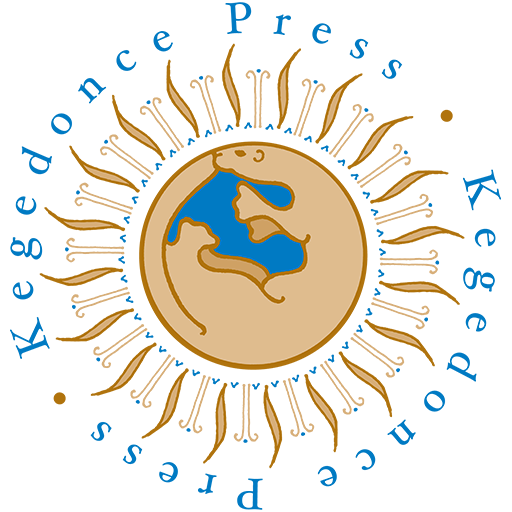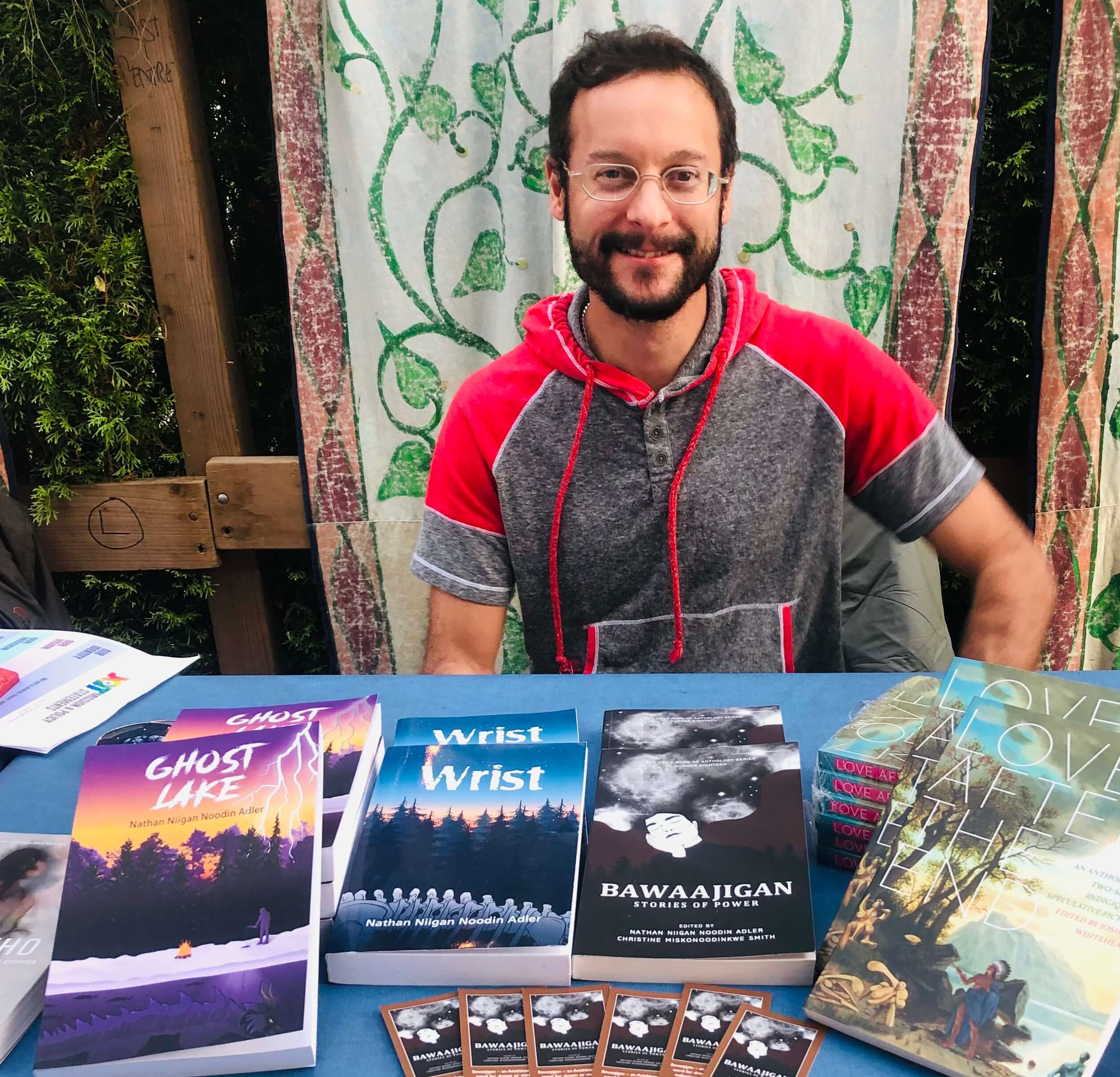Nathan Niigan Noodin Adler, author of Wrist and Ghost Lake (Kegedonce Press) and co-editor of Bawaajigan ~ Stories of Power, a dream-themed anthology of Indigenous writers (Exile Editions). He is an artist and filmmaker who works in a variety of mediums including audio and video, and drawing and painting. His writing is published in various magazines, blogs, and anthologies. He is two-spirit, Jewish, Anishinaabe, and member of Lac Des Mille Lacs First Nation. In 2021, his collection of horror/mystery stories, Ghost Lake won the Indigenous Voices award for Published Fiction. Originally from Ontario, Nathan currently resides in Vancouver where he teaches creative writing at Kwantlen University.
We caught up with Nathan to chat with him about his writing, his inspirations, and what he’s been up to lately. Here is our conversation.
Kegedonce Press: What draws you to writing horror, mystery and thriller stories? Where do you find inspiration?
Nathan Niigan Noodin Adler: I think for me the appeal of horror isn’t necessarily about an exploration of fear, although that’s supposed to be what the horror genre is about: fear, shock, and disgust. Instead for me, I feel like my approach to Horror comes from more of a Gothic aesthetic? An aesthetic that finds beauty or comfort in places or ideas or moods that most people find repulsive, morbid, disturbing or depressing; for me those things can actually be cathartic, soothing, or fun, enjoying the chaos and danger of a thunderstorm, or relishing in a gloomy rainy day or a sad song. Rooting for the underdog, monster, or bad guy in a movie. The gore even, as long as it’s not real right. The flip side is reality, sometimes the depressing reality of mortality or cruelty–whatever it is– facing that reality head-on can also be comforting somehow? Like “Yep that’s the way it is” to remind yourself some things are outside your control, so it’s not worth worrying and being anxious about it if you keep being sort of dead-pan and matter a fact about a harsh reality, right? So maybe finding humour or embracing that as an aesthetic in some way is also about fear too, disarming it pre-emptively. You have no power here, I already know. Nothing can surprise me see, no rose-coloured glasses here, no illusions.
Mystery and thriller are sort of adjacent genres. Mystery is about the unknown, and unravelling those mysteries until their inevitable conclusion, in most mystery genre narratives: you know the mystery will be solved, the killer will be caught, you just have to hang on till the end (it’s about when and how the answers will be revealed) and the feelings of suspense you experience until you find out the answers. And those are sort of the genre conventions I’ve played with in my own forays into the mystery genre, sort of challenging them by not following the conventions because they don’t exactly reflect reality most of the time. So I upended it.
The Thriller genre is sort of similar in that the primary draw through the narrative is about suspense, about what’s going to happen, about the unknown, except here the fear is usually supposed to be something real-world rather than supernatural in nature, something that could actually happen: kidnapping, espionage, murder. But sometimes the supernatural make great metaphors for the real world. What better way to talk about corporate greed than vampires that literally suck the life out of you? And sometimes, reality is so much more horrific than making up some supernatural threat, there are enough real-world threats that are just as terrifying and cruel as any supernatural monster in a horror movie. So thriller. The real monster isn’t supernatural.
So inspiration: I get a lot of inspiration from family history, other times it comes from the land, thinking about a certain place, and the history of that place. Sometimes I want to tackle a certain idea, or I’m processing something through the lens of a creative story, working through an idea or concept, and looking at it from different angles on the page. And I set out to do that pretty intentionally sometimes. Other times it’s just sort of been brewing in the background of my subconscious for years before it’s finally ready to come out. It might only take a week to sit down and write that rough draft of the story, but really it’s been fermenting for ten years. So how long did it actually take to write? Like a rock tumbler—maybe that a good metaphor?—that rock has been spinning around in there for a while now, getting washed around, so when it finally emerges it’s shiny and slick with hardly any rough edges. Other times, wham! Lightning strikes and you just start writing, who knows where that idea comes from? That character is just in your head and telling you their story, so you better write it down. Beach glass.
KP: What, in your view, are the best elements of good writing?
NNA: Hrrrm. Geez. Umm. Errr. I tend to get stuck on certain authors. I don’t know if the series or authors or books I like to read always necessarily qualify as good writing. What’s wrong with bad writing? Aside from some obvious cringe factors. I mean, people like all kinds of crappy things. Does it matter as long as they are enjoying it? As long as it’s doing the thing stories are supposed to do? As long as it isn’t pissing me off by being problematic. Does it matter if it’s high art? I like stories, I like art. I don’t always want high-brow stuff, and I don’t always want beautifully crafted dense poetic writing either, but sometimes I do. What makes good writing? What makes good art? Not an easy question. But for me I usually fall in love with the characters. If I like the characters, I’ll be hooked. Even if the writing is bad, (predictable, repetitive, clichéd, over-dramatic) I can look past that if at least the characters are interesting.
KP: When you begin writing a story, what comes to you first: plot, character, setting? Something else?
NNA: It depends on the story really. Sometimes I’ll start off with a setting, or a character as a prompt and build out organically from there, and just see where the story goes, who the character is, why they are in the place they’re at, and once one choice is made, this inevitably raises other questions, what they’re doing there, what do they want, who are they looking for etc. etc. … so follow the trail of questions, and slowly answer each one until the story is finished. The organic story process is sort of fun, because then even you as the writer don’t know where the story is going until it gets there, you have to finish writing it to find out. At some point you generally figure out where it’s going before you get to the end, sort of like fumbling around in an unfamiliar dark room searching for the light-switch, you follow the wall by touch, feel the texture of the horizontal stripe wallpaper, encounter each piece of furniture one at a time, the softness of the plush velvet couch, the tough-woven fabric of a sitting chair, stub your toe on the coffee table, bash your knee on the end table, almost knock over the floor lamp, trip over the place where the cold stone tile gives-way to carpet under your bare feet, until you get a sense of the shape of the room, what kind of room it is, and by the time you hit the light-switch you already know where you are.
KP: What are you working on now? Do you have any other books or stories in the works?
NNA: I just finished writing another short story featuring Zaude, a character from Ghost Lake who had three stories in that collection, I wanted to keep writing to see where her thread would lead, and flesh out her character a bit more. The last story in that book felt a bit open-ended, like there was more to the story, so I wanted to see what would happen next. I was thinking it might be a good fit for that Horror anthology Kegedonce is planning, but I’m not sure it ended up being scary enough, so I might have to write another one. Something more scary.
I’ve also been teaching Creative Writing at Kwantlen University, so that’s been a lot of work: course planning, lesson planning, teaching, grading, service work. I’m pretty new to the University structure, at least from the faculty side of things, so I’ve had to spend time thinking about teaching methods and philosophy, and that’s also taken up a bunch of time from my creative work. Though it is pretty awesome to be able to help others tell their stories too.
As for my writing and other creative work: I have an unfinished graphic novel I really need to finish working on, an unfinished Y/A novel, an unfinished novel. And an unfinished documentary that needs to be completed. So lots of projects to work on!

